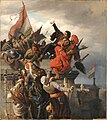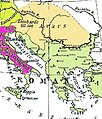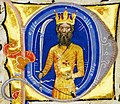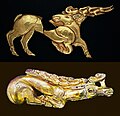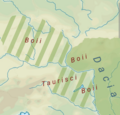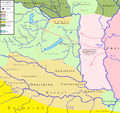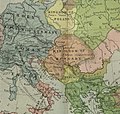Portal:Hungary
The Hungary Portal




Hungary is a landlocked country in Central Europe. Spanning 93,030 square kilometres (35,920 sq mi) of the Carpathian Basin, it is bordered by Slovakia to the north, Ukraine to the northeast, Romania to the east and southeast, Serbia to the south, Croatia and Slovenia to the southwest, and Austria to the west. Hungary has a population of 9.5 million, mostly ethnic Hungarians and a significant Romani minority. Hungarian, a language belonging to the Ugric branch of the Uralic language family, is the official language, and Budapest is the country's capital and largest city.
Prior to the foundation of the Hungarian state, various peoples settled in the territory of present-day Hungary, most notably the Celts, Romans, Huns, Germanic peoples, Avars and Slavs. The Principality of Hungary was established in the late 9th century by Álmos and his son Árpád through the conquest of the Carpathian Basin. King Stephen I ascended the throne in 1000, converting his realm to a Christian kingdom. The medieval Kingdom of Hungary was a European power, reaching its height in the 14th–15th centuries. After a long period of Ottoman wars, Hungary's forces were defeated at the Battle of Mohács and its capital was captured in 1541, opening roughly a 150 years long period when the country was divided into three parts: Royal Hungary loyal to the Habsburgs, Ottoman Hungary and the largely independent Principality of Transylvania. The reunited Hungary came under Habsburg rule at the turn of the 18th century, fighting a war of independence in 1703–1711, and a war of independence in 1848–1849 until a compromise allowed the formation of the Austro-Hungarian Monarchy in 1867, a major power into the early 20th century. Austria-Hungary collapsed after World War I, and the subsequent Treaty of Trianon in 1920 established Hungary's current borders, resulting in the loss of 71% of its historical territory, 58% of its population, and 32% of its ethnic Hungarians.
In the interwar period, after initial turmoil, Miklós Horthy ascended as a determining politician, representing the monarchy as regent in place of the Habsburgs. Hungary joined the Axis powers in World War II, suffering significant damage and casualties. As a result, the Hungarian People's Republic was established as a satellite state of the Soviet Union. Following the failed 1956 revolution, Hungary became comparatively freer, but still remained a repressed member of the Eastern Bloc. In 1989, concurrently with the Revolutions of 1989, Hungary peacefully transitioned into a democratic parliamentary republic, joining the European Union in 2004 and being part of the Schengen Area since 2007.
Hungary is a high-income economy with universal health care and tuition-free secondary education. Hungary has a long history of significant contributions to arts, music, literature, sports, science and technology. It is a popular tourist destination in Europe, drawing 24.5 million international tourists in 2019. It is a member of numerous international organisations, including the Council of Europe, NATO, United Nations, World Health Organization, World Trade Organization, World Bank, Asian Infrastructure Investment Bank, and the Visegrád Group. (Full article...)

Joseph Szigeti (Hungarian: Szigeti József, [ˈsiɡɛti ˈjoːʒɛf]; 5 September 1892 – 19 February 1973) was a Hungarian violinist.
Born into a musical family, he spent his early childhood in a small town in Transylvania. He quickly proved himself to be a child prodigy on the violin, and moved to Budapest with his father to study with the renowned pedagogue Jenő Hubay. After completing his studies with Hubay in his early teens, Szigeti began his international concert career. His performances at that time were primarily limited to salon-style recitals and the more overtly virtuosic repertoire; however, after making the acquaintance of pianist Ferruccio Busoni, he began to develop a much more thoughtful and intellectual approach to music that eventually earned him the nickname "The Scholarly Virtuoso". (Full article...)Selected article -

People
- Musicians
Béla Bartók – János Bihari – Ernő Dohnányi – Béni Egressy – Ferenc Erkel – Zoltán Kocsis – Zoltán Kodály – Franz Liszt - Eugene Ormandy - George Szell - András Schiff
- Painters
Gyula Benczúr – Tivadar Csontváry Kosztka – Béla Czóbel – Árpád Feszty – Károly Lotz – Viktor Madarász – Mihály Munkácsy – József Rippl-Rónai – Pál Szinyei Merse – István Szőnyi – Victor Vasarely
- Photographers
Brassaï – Cornell Capa – Robert Capa – Lucien Hervé – André Kertész – László Moholy-Nagy – Martin Munkácsi
- Scientists
Béla H. Bánáthy – Zoltán Bay – Georg von Békésy – Farkas Bolyai – János Bolyai – Károly Bund – József Eötvös – Loránd Eötvös – Dennis Gabor – John Charles Harsanyi – George de Hevesy – Alexander Csoma de Kőrös – László Lovász – John von Neumann – George Andrew Olah – Ernő Rubik – Hans Selye – Ignaz Semmelweis – Charles Simonyi – János Szentágothai – Albert Szent-Györgyi – Leó Szilárd – Edward Teller – Eugene Wigner
- Writers and poets
Endre Ady – János Arany – József Eötvös – György Faludy – Béla Hamvas – Mór Jókai – Attila József – Ferenc Kazinczy – Imre Kertész – János Kodolányi – Ferenc Kölcsey – Imre Madách – Sándor Márai – Ferenc Molnár – Sándor Petőfi – Miklós Radnóti – Magda Szabó – Antal Szerb – Miklós Vámos – Mihály Vörösmarty
- Statesmen, Politicians and Military
Gyula Andrássy – Lajos Batthyány – Gabriel Bethlen – Stephen Bocskay – Matthias Corvinus – Ferenc Deák – Miklós Horthy – Lajos Kossuth – Ferenc Nagy – Imre Nagy – Bertalan Szemere – István Széchenyi – Miklós Wesselényi – Vilmos Nagy of Nagybaczon
- Sportspeople
József Bozsik – Krisztina Egerszegi – Zoltán Gera – Dezső Gyarmati – Ágnes Keleti – Péter Lékó – Csaba Mérő – Tibor Nyilasi – László Papp – Judit Polgár – Zsuzsa Polgár – Ferenc Puskás
- Film & Stage
Nimród Antal – Michael Curtiz – John Garfield – Miklós Jancsó – Sir Alexander Korda – Peter Lorre – Béla Lugosi – Emeric Pressburger – Miklós Rózsa – Andy G. Vajna – Gábor Zsazsa
The Battle of Kerlés (Hungarian: kerlési csata) also known as the Battle of Cserhalom (Hungarian: cserhalmi csata), was an engagement between an army of Pechenegs and Ouzes commanded by Osul and the troops of King Solomon of Hungary and his cousins, Dukes Géza and Ladislaus, in Transylvania in 1068. The Pechenegs had been the dominant power of the westernmost regions of the Eurasian steppes since around 895. However, large Pecheneg groups moved to the Balkan Peninsula at the same time as the westward migration of the Ouzes and Cumans in the 1040s. The first recorded Pecheneg invasion of Transylvania occurred during the reign of Stephen I of Hungary (r. 997–1038).
In 1068, the invaders broke into Transylvania through the passes of the Carpathian Mountains. Archaeological finds suggest that they destroyed at least three fortresses made of earth and timber, including the ones at Doboka (now Dăbâca in Romania) and Sajósárvár (present-day Șirioara). They also made a plundering raid in the Nyírség region, to the west of Transylvania. After taking much booty, they planned to leave Hungary, but the Hungarians ambushed and annihilated them at a hill near Doboka. According to a popular legend, a "Cuman" warrior tried to escape from the battlefield, taking a Hungarian girl, but Duke Ladislaus defeated and killed him in single combat. (Full article...)Selected picture
Wikiprojects
Related projects:
Related portals
Things you can do
| The following stub articles would benefit from expansion. | |
General images -
The following are images from various Hungary-related articles on Wikipedia.
Topics
Categories
New articles
Rules | Match log | Results page (for watching) | Last updated: 2024-08-04 20:47 (UTC)
Note: The list display can now be customized by each user. See List display personalization for details.
- Boglárka Neszmély (edit | talk | history | links | watch | logs | tools) by Edgars2007 (talk · contribs · new pages (186)) started on 2024-08-04, score: 40
- Kamilla Faragó (edit | talk | history | links | watch | logs | tools) by Edgars2007 (talk · contribs · new pages (186)) started on 2024-08-04, score: 40
- Brigitta Horváth (edit | talk | history | links | watch | logs | tools) by Edgars2007 (talk · contribs · new pages (186)) started on 2024-08-04, score: 40
- Geraldine Mahieu (edit | talk | history | links | watch | logs | tools) by Edgars2007 (talk · contribs · new pages (186)) started on 2024-08-04, score: 40
- Márk Bányai (edit | talk | history | links | watch | logs | tools) by Edgars2007 (talk · contribs · new pages (186)) started on 2024-08-04, score: 40
- Vince Vigvári (edit | talk | history | links | watch | logs | tools) by Edgars2007 (talk · contribs · new pages (186)) started on 2024-08-04, score: 40
- Gergő Fekete (edit | talk | history | links | watch | logs | tools) by Edgars2007 (talk · contribs · new pages (186)) started on 2024-08-04, score: 60
- Ádám Nagy (water polo) (edit | talk | history | links | watch | logs | tools) by Edgars2007 (talk · contribs · new pages (186)) started on 2024-08-04, score: 40
- Erik Molnár (water polo) (edit | talk | history | links | watch | logs | tools) by Edgars2007 (talk · contribs · new pages (186)) started on 2024-08-04, score: 40
- Lauren Brzykcy (edit | talk | history | links | watch | logs | tools) by Das osmnezz (talk · contribs · new pages (58)) started on 2024-08-04, score: 40
- 2000 Westel 900 Budapest Open – Doubles (edit | talk | history | links | watch | logs | tools) by Pablito064 (talk · contribs · new pages (5)) started on 2024-08-04, score: 40
- Hungarian Society for Urban and Spatial Planning (edit | talk | history | links | watch | logs | tools) by Freewales (talk · contribs · new pages (1)) started on 2024-08-03, score: 130
- 1990–91 in Swiss football (edit | talk | history | links | watch | logs | tools) by Huligan0 (talk · contribs · new pages (1)) started on 2024-08-03, score: 20
- Judita Alargić (edit | talk | history | links | watch | logs | tools) by Lajmmoore (talk · contribs · new pages (12)) started on 2024-08-03, score: 20
- MÁV Class 414 (edit | talk | history | links | watch | logs | tools) by DBS (talk · contribs · new pages (1)) started on 2024-08-03, score: 80
- Marissa Williamson (edit | talk | history | links | watch | logs | tools) by Jonny Nixon (talk · contribs · new pages (11)) started on 2024-08-03, score: 20
- József Sadler (edit | talk | history | links | watch | logs | tools) by Shyamal (talk · contribs · new pages (26)) started on 2024-08-03, score: 60
- Nikolai Terteryan (edit | talk | history | links | watch | logs | tools) by Fixer88 (talk · contribs · new pages (64)) started on 2024-08-03, score: 20
- Mohammed Dwedar (edit | talk | history | links | watch | logs | tools) by IvanScrooge98 (talk · contribs · new pages (17)) started on 2024-08-03, score: 30
- Dávid Nagy (edit | talk | history | links | watch | logs | tools) by Einstein2 (talk · contribs · new pages (3)) started on 2024-08-02, score: 20
- Javier Ibáñez (edit | talk | history | links | watch | logs | tools) by MoviesandTelevisionFan (talk · contribs · new pages (39)) started on 2024-08-02, score: 30
- Sodomka (edit | talk | history | links | watch | logs | tools) by TKOIII (talk · contribs · new pages (2)) started on 2024-08-02, score: 30
- Ion Creangă (edit | talk | history | links | watch | logs | tools) by Stickhandler (talk · contribs · new pages (38)) started on 2024-08-01, score: 20
- Battle of Kraków (1914) (edit | talk | history | links | watch | logs | tools) by Dushnilkin (talk · contribs · new pages (4)) started on 2024-08-02, score: 40
- Negol (edit | talk | history | links | watch | logs | tools) by Norden1990 (talk · contribs · new pages (11)) started on 2024-08-02, score: 160
- 2024–25 Megyei Bajnokság I (edit | talk | history | links | watch | logs | tools) by Rakeck (talk · contribs · new pages (15)) started on 2024-08-02, score: 480
- Dávid Nagy (fencer) (edit | talk | history | links | watch | logs | tools) by BeanieFan11 (talk · contribs · new pages (86)) started on 2024-08-02, score: 20
- Donát Varga (edit | talk | history | links | watch | logs | tools) by Hildreth gazzard (talk · contribs · new pages (420)) started on 2024-08-02, score: 70
- Dániel Rába (edit | talk | history | links | watch | logs | tools) by Hildreth gazzard (talk · contribs · new pages (420)) started on 2024-08-02, score: 70
- Kerlenn Pondi (edit | talk | history | links | watch | logs | tools) by Shenaall (talk · contribs · new pages (3)) started on 2024-08-02, score: 20
- Sydney Francisco (edit | talk | history | links | watch | logs | tools) by BeanieFan11 (talk · contribs · new pages (86)) started on 2024-08-01, score: 20
- András László (politician) (edit | talk | history | links | watch | logs | tools) by Cilidus (talk · contribs · new pages (165)) started on 2024-08-01, score: 40
- Zsuzsanna Borvendég (edit | talk | history | links | watch | logs | tools) by Cilidus (talk · contribs · new pages (165)) started on 2024-08-01, score: 60
- Sophio Somkhishvili (edit | talk | history | links | watch | logs | tools) by Fixer88 (talk · contribs · new pages (64)) started on 2024-07-30, score: 20
- Luca Hámori (edit | talk | history | links | watch | logs | tools) by PatGallacher (talk · contribs · new pages (3)) started on 2024-08-01, score: 60
- Serhii Svystun (edit | talk | history | links | watch | logs | tools) by Ceriy (talk · contribs · new pages (5)) started on 2024-08-01, score: 80
- Football at the 1960 Summer Olympics – Group 4 (edit | talk | history | links | watch | logs | tools) by FastCube (talk · contribs · new pages (8)) started on 2024-08-01, score: 80
- Classical music lists (edit | talk | history | links | watch | logs | tools) by Gor1995 (talk · contribs · new pages (1)) started on 2024-08-01, score: 50
- Lilla Minna Ábrahám (edit | talk | history | links | watch | logs | tools) by Edgars2007 (talk · contribs · new pages (186)) started on 2024-08-01, score: 40
- National records in the 400 metres hurdles (edit | talk | history | links | watch | logs | tools) by Afasmit (talk · contribs · new pages (1)) started on 2024-08-01, score: 30
- Our Lovely Pig Slaughter (edit | talk | history | links | watch | logs | tools) by Bedivere.cs (talk · contribs · new pages (13)) started on 2024-08-01, score: 20
- Myriam Djekoundade (edit | talk | history | links | watch | logs | tools) by Fixer88 (talk · contribs · new pages (64)) started on 2024-08-01, score: 20
- Isotta Sportelli (edit | talk | history | links | watch | logs | tools) by Dmhll (talk · contribs · new pages (4)) started on 2024-08-01, score: 30
- Non-attached members (edit | talk | history | links | watch | logs | tools) by Mathglot (talk · contribs · new pages (14)) started on 2024-08-01, score: 70
- Lukoil oil transit dispute (edit | talk | history | links | watch | logs | tools) by Noble Attempt (talk · contribs · new pages (20)) started on 2024-07-31, score: 50
- Jampec (edit | talk | history | links | watch | logs | tools) by Konnor Martin (talk · contribs · new pages (2)) started on 2024-07-31, score: 70
- Csongor Lehmann (edit | talk | history | links | watch | logs | tools) by Seacactus 13 (talk · contribs · new pages (32)) started on 2024-07-31, score: 60
- Endre Németi (edit | talk | history | links | watch | logs | tools) by Norden1990 (talk · contribs · new pages (11)) started on 2024-07-31, score: 110
- Christine Kelley (edit | talk | history | links | watch | logs | tools) by David Eppstein (talk · contribs · new pages (24)) started on 2024-07-31, score: 20
- Zoi Fitsiou (edit | talk | history | links | watch | logs | tools) by Hildreth gazzard (talk · contribs · new pages (420)) started on 2024-07-31, score: 30
- Dimitra Kontou (edit | talk | history | links | watch | logs | tools) by Hildreth gazzard (talk · contribs · new pages (420)) started on 2024-07-31, score: 30
- Richárd Kovács (edit | talk | history | links | watch | logs | tools) by Basetornado (talk · contribs · new pages (1)) started on 2024-07-31, score: 60
- Fencing at the 2024 Summer Olympics – Men's team sabre (edit | talk | history | links | watch | logs | tools) by Kante4 (talk · contribs · new pages (44)) started on 2024-07-26, score: 20
- Diána Németh (edit | talk | history | links | watch | logs | tools) by Lisbean (talk · contribs · new pages (42)) started on 2024-07-31, score: 60
- Lars Benske (edit | talk | history | links | watch | logs | tools) by Hildreth gazzard (talk · contribs · new pages (420)) started on 2024-07-31, score: 30
- Ask Jarl Tjøm (edit | talk | history | links | watch | logs | tools) by Hildreth gazzard (talk · contribs · new pages (420)) started on 2024-07-31, score: 30
- Krisztián Rabb (edit | talk | history | links | watch | logs | tools) by BeanieFan11 (talk · contribs · new pages (86)) started on 2024-07-31, score: 20
- Shayetet 15 (edit | talk | history | links | watch | logs | tools) by M Waleed (talk · contribs · new pages (5)) started on 2024-07-31, score: 20
- Luca Papp (edit | talk | history | links | watch | logs | tools) by Lisbean (talk · contribs · new pages (42)) started on 2024-07-31, score: 80
- Maren Völz (edit | talk | history | links | watch | logs | tools) by Hildreth gazzard (talk · contribs · new pages (420)) started on 2024-07-31, score: 20
- Pia Greiten (edit | talk | history | links | watch | logs | tools) by Hildreth gazzard (talk · contribs · new pages (420)) started on 2024-07-31, score: 20
- 2024–25 Alaska Anchorage Seawolves men's ice hockey season (edit | talk | history | links | watch | logs | tools) by PensRule11385 (talk · contribs · new pages (26)) started on 2024-07-31, score: 20
- Giberville bucket (edit | talk | history | links | watch | logs | tools) by Fortunate Girl (talk · contribs · new pages (5)) started on 2024-07-31, score: 20
- Richárd Kovács (boxer) (edit | talk | history | links | watch | logs | tools) by Basetornado (talk · contribs · new pages (1)) started on 2024-07-31, score: 60
- Ballagás (edit | talk | history | links | watch | logs | tools) by Konnor Martin (talk · contribs · new pages (2)) started on 2024-07-31, score: 80
- Marie-Ève Paget (edit | talk | history | links | watch | logs | tools) by Fixer88 (talk · contribs · new pages (64)) started on 2024-07-30, score: 20
- Kinga Kollár (edit | talk | history | links | watch | logs | tools) by Cilidus (talk · contribs · new pages (165)) started on 2024-07-30, score: 60
- Gilles Carle: The Untamable Mind (edit | talk | history | links | watch | logs | tools) by Bearcat (talk · contribs · new pages (85)) started on 2024-07-30, score: 20
- Christoph von Wydenbruck (edit | talk | history | links | watch | logs | tools) by DACC23 (talk · contribs · new pages (64)) started on 2024-07-30, score: 40
- Peter Köbölkúti (edit | talk | history | links | watch | logs | tools) by Norden1990 (talk · contribs · new pages (11)) started on 2024-07-30, score: 150
- List of minor planets: 719001–720000 (edit | talk | history | links | watch | logs | tools) by Tom.Reding (talk · contribs · new pages (244)) started on 2024-07-22, score: 20
- List of minor planets: 718001–719000 (edit | talk | history | links | watch | logs | tools) by Tom.Reding (talk · contribs · new pages (244)) started on 2024-07-22, score: 20
- List of minor planets: 716001–717000 (edit | talk | history | links | watch | logs | tools) by Tom.Reding (talk · contribs · new pages (244)) started on 2024-07-22, score: 20
- List of minor planets: 715001–716000 (edit | talk | history | links | watch | logs | tools) by Tom.Reding (talk · contribs · new pages (244)) started on 2024-07-22, score: 20
- List of minor planets: 714001–715000 (edit | talk | history | links | watch | logs | tools) by Tom.Reding (talk · contribs · new pages (244)) started on 2024-07-22, score: 20
- List of minor planets: 712001–713000 (edit | talk | history | links | watch | logs | tools) by Tom.Reding (talk · contribs · new pages (244)) started on 2024-07-22, score: 20
- List of minor planets: 707001–708000 (edit | talk | history | links | watch | logs | tools) by Tom.Reding (talk · contribs · new pages (244)) started on 2024-07-22, score: 20
- List of minor planets: 706001–707000 (edit | talk | history | links | watch | logs | tools) by Tom.Reding (talk · contribs · new pages (244)) started on 2024-07-22, score: 20
- 15 cm MRK L/35 (edit | talk | history | links | watch | logs | tools) by Grieg2 (talk · contribs · new pages (2)) started on 2024-07-30, score: 20
- Georg, 6th Prince Fugger von Babenhausen (edit | talk | history | links | watch | logs | tools) by DACC23 (talk · contribs · new pages (64)) started on 2024-07-30, score: 20
- Endre (vice-palatine) (edit | talk | history | links | watch | logs | tools) by Norden1990 (talk · contribs · new pages (11)) started on 2024-07-30, score: 100
- Fares Badawi (edit | talk | history | links | watch | logs | tools) by IvanScrooge98 (talk · contribs · new pages (17)) started on 2024-07-30, score: 20
- Németi (genus) (edit | talk | history | links | watch | logs | tools) by Norden1990 (talk · contribs · new pages (11)) started on 2024-07-30, score: 120
- Central European studies (edit | talk | history | links | watch | logs | tools) by LSNAWQ (talk · contribs · new pages (1)) started on 2024-07-30, score: 20
- Russia in the First World War (edit | talk | history | links | watch | logs | tools) by Cerebellum (talk · contribs · new pages (4)) started on 2024-07-30, score: 20
- Osyp Makovei (edit | talk | history | links | watch | logs | tools) by Максим Огородник (talk · contribs · new pages (146)) started on 2024-07-30, score: 40
- 2024–25 Nemzeti Bajnokság II (edit | talk | history | links | watch | logs | tools) by Rakeck (talk · contribs · new pages (15)) started on 2024-07-30, score: 160
- Rumah Panggung Betawi (edit | talk | history | links | watch | logs | tools) by Badak Jawa (talk · contribs · new pages (3)) started on 2024-07-30, score: 20
- Hungaria family (edit | talk | history | links | watch | logs | tools) by Exoplanetaryscience (talk · contribs · new pages (9)) started on 2024-07-30, score: 40
- Enver Sherfedinov (edit | talk | history | links | watch | logs | tools) by Devlet Geray (talk · contribs · new pages (12)) started on 2024-07-29, score: 20
- Sandra Ygueravide (edit | talk | history | links | watch | logs | tools) by Fixer88 (talk · contribs · new pages (64)) started on 2024-07-29, score: 20
- Adil Osmanov (edit | talk | history | links | watch | logs | tools) by Hildreth gazzard (talk · contribs · new pages (420)) started on 2024-07-29, score: 20
- 2022 IHF Women's U18 Handball World Championship squads (edit | talk | history | links | watch | logs | tools) by Stojan212 (talk · contribs · new pages (1)) started on 2024-07-29, score: 50
- Historical Archive of Senta (edit | talk | history | links | watch | logs | tools) by MirkoS18 (talk · contribs · new pages (38)) started on 2024-07-29, score: 40
- Historical Archive of Subotica (edit | talk | history | links | watch | logs | tools) by MirkoS18 (talk · contribs · new pages (38)) started on 2024-07-29, score: 40
- Jan Schäuble (edit | talk | history | links | watch | logs | tools) by Hildreth gazzard (talk · contribs · new pages (420)) started on 2024-07-29, score: 20
- Raphaël Ahumada (edit | talk | history | links | watch | logs | tools) by Hildreth gazzard (talk · contribs · new pages (420)) started on 2024-07-29, score: 20
- Historical Archive of Kikinda (edit | talk | history | links | watch | logs | tools) by MirkoS18 (talk · contribs · new pages (38)) started on 2024-07-29, score: 40
- Josef Zastyretz (edit | talk | history | links | watch | logs | tools) by Максим Огородник (talk · contribs · new pages (146)) started on 2024-07-29, score: 20
- Jenna Forrester (edit | talk | history | links | watch | logs | tools) by Fixer88 (talk · contribs · new pages (64)) started on 2024-07-29, score: 20
- Hilbert system (edit | talk | history | links | watch | logs | tools) by 2A00:8A60:C010:1:0:0:1:101F (talk · contribs · new pages (1)) started on 2024-07-28, score: 30
- Into Darkness (novelette) (edit | talk | history | links | watch | logs | tools) by Samuel Adrian Antz (talk · contribs · new pages (4)) started on 2024-07-28, score: 20
- Romfell armoured car (edit | talk | history | links | watch | logs | tools) by Tengu99 (talk · contribs · new pages (5)) started on 2024-07-28, score: 60
- Tibor Andrásfi (edit | talk | history | links | watch | logs | tools) by BeanieFan11 (talk · contribs · new pages (86)) started on 2024-07-28, score: 20
- Christopher Columbus (Zador) (edit | talk | history | links | watch | logs | tools) by 4meter4 (talk · contribs · new pages (40)) started on 2024-07-28, score: 20
- 2024–25 Nemzeti Bajnokság III (edit | talk | history | links | watch | logs | tools) by Skyblueshaun (talk · contribs · new pages (9)) started on 2024-07-28, score: 220
- Balázs Kaizinger (edit | talk | history | links | watch | logs | tools) by Rytter192 (talk · contribs · new pages (12)) started on 2024-07-28, score: 60
- Hayley Wong (edit | talk | history | links | watch | logs | tools) by Pangalau (talk · contribs · new pages (58)) started on 2024-07-28, score: 20
- Sidonie Hönig (edit | talk | history | links | watch | logs | tools) by Ploni (talk · contribs · new pages (7)) started on 2024-07-28, score: 40
- Mascha Ballhaus (edit | talk | history | links | watch | logs | tools) by Fixer88 (talk · contribs · new pages (64)) started on 2024-07-28, score: 20
- Andrei Cornea (edit | talk | history | links | watch | logs | tools) by JeyReydar97 (talk · contribs · new pages (38)) started on 2024-07-27, score: 20
- Giedrius Bieliauskas (edit | talk | history | links | watch | logs | tools) by Hildreth gazzard (talk · contribs · new pages (420)) started on 2024-07-27, score: 30
- Eszter Muhari (edit | talk | history | links | watch | logs | tools) by Einstein2 (talk · contribs · new pages (3)) started on 2024-07-27, score: 60
- 1948 Beechcraft Model 18 disappearance (edit | talk | history | links | watch | logs | tools) by Global Donald (talk · contribs · new pages (34)) started on 2024-07-27, score: 20
- Petra Simon (edit | talk | history | links | watch | logs | tools) by Fakez76 (talk · contribs · new pages (1)) started on 2024-07-27, score: 100
- Roland Borșa (edit | talk | history | links | watch | logs | tools) by Zetconnect (talk · contribs · new pages (1)) started on 2024-07-26, score: 40
- Lőrinte (genus) (edit | talk | history | links | watch | logs | tools) by Norden1990 (talk · contribs · new pages (11)) started on 2024-07-26, score: 90
- Hungarian Community (Terre Haute) (edit | talk | history | links | watch | logs | tools) by MicElise (talk · contribs · new pages (2)) started on 2024-07-26, score: 20
- Historical Archive of Novi Sad (edit | talk | history | links | watch | logs | tools) by MirkoS18 (talk · contribs · new pages (38)) started on 2024-07-26, score: 40
- 2024–25 Puskás Akadémia FC season (edit | talk | history | links | watch | logs | tools) by EpicAdventurer (talk · contribs · new pages (40)) started on 2024-07-26, score: 50
- Historical Archive of Sombor (edit | talk | history | links | watch | logs | tools) by MirkoS18 (talk · contribs · new pages (38)) started on 2024-07-26, score: 40
- Historical Archive of Bela Crkva (edit | talk | history | links | watch | logs | tools) by MirkoS18 (talk · contribs · new pages (38)) started on 2024-07-26, score: 60
- Yevhen Nahirnyi (edit | talk | history | links | watch | logs | tools) by Максим Огородник (talk · contribs · new pages (146)) started on 2024-07-26, score: 20
- 2024 Belgian Grand Prix (edit | talk | history | links | watch | logs | tools) by FearfulWarpII (talk · contribs · new pages (0)) started on 2024-07-26, score: 20
- András Selei (edit | talk | history | links | watch | logs | tools) by Rakeck (talk · contribs · new pages (15)) started on 2024-07-25, score: 100
- Viktória Ferenc (edit | talk | history | links | watch | logs | tools) by Cilidus (talk · contribs · new pages (165)) started on 2024-07-25, score: 80
- Historical Archive of Zrenjanin (edit | talk | history | links | watch | logs | tools) by MirkoS18 (talk · contribs · new pages (38)) started on 2024-07-23, score: 50
- The Rescuers Documentary (edit | talk | history | links | watch | logs | tools) by ForHumanityIAm (talk · contribs · new pages (2)) started on 2024-07-22, score: 20
- 1936 Summer Olympics national flag bearers (edit | talk | history | links | watch | logs | tools) by EasonChiu610 (talk · contribs · new pages (1)) started on 2024-07-25, score: 20
- Philippe Zeller (edit | talk | history | links | watch | logs | tools) by McSyl (talk · contribs · new pages (30)) started on 2024-07-25, score: 60
- Anna Albek (edit | talk | history | links | watch | logs | tools) by Edgars2007 (talk · contribs · new pages (186)) started on 2024-07-25, score: 60
- Topmodell (season 1) (edit | talk | history | links | watch | logs | tools) by AimiqaXerni (talk · contribs · new pages (2)) started on 2024-07-25, score: 140
- Next Top Model Hungary (season 2) (edit | talk | history | links | watch | logs | tools) by AimiqaXerni (talk · contribs · new pages (2)) started on 2024-07-25, score: 140
- Krisztián Tímár (edit | talk | history | links | watch | logs | tools) by OPES-FRM (talk · contribs · new pages (1)) started on 2024-07-25, score: 160
- Olena Havrylko (edit | talk | history | links | watch | logs | tools) by Максим Огородник (talk · contribs · new pages (146)) started on 2024-07-25, score: 20
- Westminster Music Library (edit | talk | history | links | watch | logs | tools) by Sfjohna (talk · contribs · new pages (1)) started on 2024-07-25, score: 20
- 2024–25 Debreceni VSC (women's handball) season (edit | talk | history | links | watch | logs | tools) by Cakesam (talk · contribs · new pages (1)) started on 2024-07-25, score: 160
- Gabriella Gerzsenyi (edit | talk | history | links | watch | logs | tools) by Cilidus (talk · contribs · new pages (165)) started on 2024-07-25, score: 60
- List of solved missing person cases: 1950–1999 (edit | talk | history | links | watch | logs | tools) by WhatamIdoing (talk · contribs · new pages (3)) started on 2024-07-24, score: 20
- List of solved missing person cases: pre-1950 (edit | talk | history | links | watch | logs | tools) by WhatamIdoing (talk · contribs · new pages (3)) started on 2024-07-24, score: 20
- 2007–08 FC Sopron season (edit | talk | history | links | watch | logs | tools) by Rakeck (talk · contribs · new pages (15)) started on 2024-07-24, score: 260
- Marie von Bülow (edit | talk | history | links | watch | logs | tools) by Napalatt (talk · contribs · new pages (1)) started on 2024-07-24, score: 30
- Zoltán Tefner (edit | talk | history | links | watch | logs | tools) by George Yul (talk · contribs · new pages (2)) started on 2024-07-24, score: 80
- Irena Grudzińska-Gross (edit | talk | history | links | watch | logs | tools) by Miraclepine (talk · contribs · new pages (36)) started on 2024-07-24, score: 20
- Tilloidea (edit | talk | history | links | watch | logs | tools) by Edibobb (talk · contribs · new pages (202)) started on 2024-07-23, score: 20
- Međimurje under Hungarian rule (edit | talk | history | links | watch | logs | tools) by Silverije (talk · contribs · new pages (2)) started on 2024-07-23, score: 100
- Pontechium (edit | talk | history | links | watch | logs | tools) by Tom Radulovich (talk · contribs · new pages (93)) started on 2024-07-23, score: 30
- Eszter Lakos (edit | talk | history | links | watch | logs | tools) by Cilidus (talk · contribs · new pages (165)) started on 2024-07-23, score: 80
- Gábor Reisz (edit | talk | history | links | watch | logs | tools) by Cavarrone (talk · contribs · new pages (77)) started on 2024-07-23, score: 70
- Vantage Towers (edit | talk | history | links | watch | logs | tools) by 195.233.26.91 (talk · contribs · new pages (2)) started on 2024-07-23, score: 20
- Lőrinte II Lőrinte (edit | talk | history | links | watch | logs | tools) by Norden1990 (talk · contribs · new pages (11)) started on 2024-07-23, score: 120
- Gulácsi László (edit | talk | history | links | watch | logs | tools) by H.motaharinezhad (talk · contribs · new pages (1)) started on 2024-07-23, score: 80
- Bosnia and Herzegovina–Canada relations (edit | talk | history | links | watch | logs | tools) by LibStar (talk · contribs · new pages (1)) started on 2024-07-23, score: 20
- 71st Sydney Film Festival (edit | talk | history | links | watch | logs | tools) by Bearcat (talk · contribs · new pages (85)) started on 2024-07-23, score: 20
- Historical Archive of Belgrade (edit | talk | history | links | watch | logs | tools) by MirkoS18 (talk · contribs · new pages (38)) started on 2024-07-22, score: 20
- Franz Dinghofer (edit | talk | history | links | watch | logs | tools) by THeShavidow1 (talk · contribs · new pages (16)) started on 2024-07-22, score: 20
- Visonta (edit | talk | history | links | watch | logs | tools) by Marvanyember (talk · contribs · new pages (1)) started on 2024-07-22, score: 40
- Gréta Nemcsek (edit | talk | history | links | watch | logs | tools) by Mellamelina (talk · contribs · new pages (53)) started on 2024-07-21, score: 70
- Nariman Khan Qavam al-Saltaneh (edit | talk | history | links | watch | logs | tools) by HistoryofIran (talk · contribs · new pages (23)) started on 2024-07-22, score: 20
- Gabor Lenđel (edit | talk | history | links | watch | logs | tools) by Ostalocutanje (talk · contribs · new pages (7)) started on 2024-07-22, score: 70
- Dominique Malonga (basketball) (edit | talk | history | links | watch | logs | tools) by DetroitFan7 (talk · contribs · new pages (45)) started on 2024-07-22, score: 20
- Curvature Carpathians (edit | talk | history | links | watch | logs | tools) by Andrei Stroe (talk · contribs · new pages (2)) started on 2024-07-22, score: 40
- Peter Biroš (edit | talk | history | links | watch | logs | tools) by Newklear007 (talk · contribs · new pages (6)) started on 2024-07-22, score: 40
- Mohammad Nabi Rezaei (edit | talk | history | links | watch | logs | tools) by InfoSportWiki (talk · contribs · new pages (4)) started on 2024-07-22, score: 20
- 2000 Westel 900 Budapest Open – Singles (edit | talk | history | links | watch | logs | tools) by Pablito064 (talk · contribs · new pages (5)) started on 2024-07-22, score: 40
- Kotaro Kiyooka (edit | talk | history | links | watch | logs | tools) by Tomascr7 (talk · contribs · new pages (1)) started on 2024-07-21, score: 70
- Our Sisters-in-Law (edit | talk | history | links | watch | logs | tools) by Bearcat (talk · contribs · new pages (85)) started on 2024-07-21, score: 20
- Melinda Bíró (edit | talk | history | links | watch | logs | tools) by Mellamelina (talk · contribs · new pages (53)) started on 2024-07-21, score: 80
- Hans Georg Hofmann (edit | talk | history | links | watch | logs | tools) by Historybuff0105 (talk · contribs · new pages (9)) started on 2024-07-21, score: 20
- Tayamika Chang'anamuno (edit | talk | history | links | watch | logs | tools) by Hildreth gazzard (talk · contribs · new pages (420)) started on 2024-07-21, score: 20
- Oleksandr Malyshenko (edit | talk | history | links | watch | logs | tools) by Das osmnezz (talk · contribs · new pages (58)) started on 2024-07-21, score: 50
- Safiye Sultan (Haseki of Murad III) (edit | talk | history | links | watch | logs | tools) by 103.113.149.199 (talk · contribs · new pages (1)) started on 2024-07-16, score: 30
Associated Wikimedia
The following Wikimedia Foundation sister projects provide more on this subject:
-
Commons
Free media repository -
Wikibooks
Free textbooks and manuals -
Wikidata
Free knowledge base -
Wikinews
Free-content news -
Wikiquote
Collection of quotations -
Wikisource
Free-content library -
Wikiversity
Free learning tools -
Wikivoyage
Free travel guide -
Wiktionary
Dictionary and thesaurus











